No results were found for the filter!

Gabriel Fauré
Berceuse op. 16 Violin and piano
Fauré originally composed this little piece for violin and piano and later arranged it for violin and orchestra. The edition contains QR codes to playalongs in various tempi with the original piano setting. Level of difficulty 2* : Must be looked at before the lesson, practised before the concert * For the most part, it is sufficient to play the left hand (in class). The edition is also available as a pdf file. Click on the drop-down menu under ‘Issue (please select)’
Mehr €9.00 *
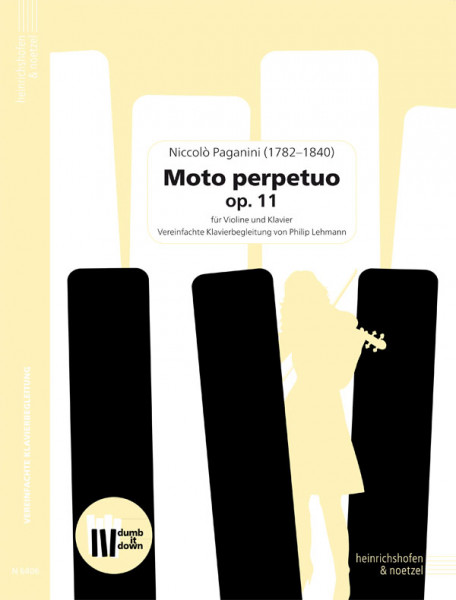
Niccolò Paganini
Perpetual Motion op. 11 Violin and piano
From practice for practice: ‘dumb it down’ is a series of simplified piano accompaniments by Philip Lehmann to standard works for various instruments, which also offer piano players without a degree the opportunity to accompany their pupils, children, friends, etc. Paganini wrote the ‘Moto Perpetuo’ like many other works for himself for violin and orchestra. The edition includes QR codes to playalongs in various tempi with the original piano setting. Level of difficulty 2* : Must be looked at before the lesson, practised before the concert * For the most part, it is sufficient to play the left hand (in class) The edition is also available as a pdf file. Click on the drop-down menu under ‘ISSUE (please select)’.
Mehr €10.50 *

Jules Massenet
Meditation from 'Thais' Viola and piano
The ‘Meditation’ is only a very short piece in the opera ‘Thais’, which is originally scored for violin and orchestra. The original key is D major. In order to do justice to the ambitus of the viola, G major was chosen. From practice for practice: ‘dumb it down’ is a series of simplified piano accompaniments to standard works for various instruments, which also offer piano players without a degree the opportunity to accompany their pupils, children, friends etc. Level of difficulty 2 : must be looked at before the lesson, practised before the concert The edition is also available as a pdf file. Click on the drop-down menu under ‘Issue (please select)’.
Mehr €9.00 *
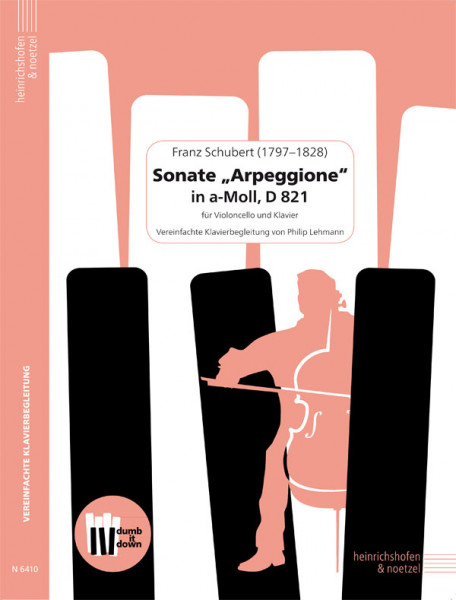
Franz Schubert
Sonata ‘Arpeggione’ in A minor, D821 Violoncello and piano
The ‘dumb it down’ series offers simplified piano accompaniments by Philip Lehmann to works for violin, viola, violoncello, flute, clarinet and other instruments. The edition includes QR codes to playalongs in various tempi with original piano settings. Level of difficulty 4 : Compared to the original, the piano setting is greatly simplified, but can still be practised by amateurs The edition is also available as a pdf file. Click on the drop-down menu under ‘ISSUE (please select)’.
Mehr €15.50 *
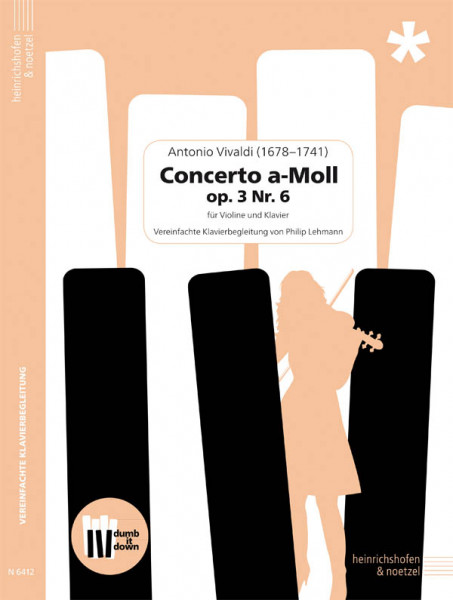
Antonio Vivaldi
Concerto in A minor op. 3 No. 6 Violin and piano
The series ‘dumb it down’ offers simplified piano accompaniments by Philip Lehmann to standard works for violin, viola, violoncello, flute, clarinet and other instruments. Level of difficulty 3* : Fingerings may need to be entered and practised * For the most part it is sufficient to play the left hand (in lessons) The edition is also available as a pdf file. Click on the drop-down menu under ‘Issue (please select)’
Mehr €10.50 *

Peter Iljitsch...
Chanson triste, op.40 No.2 Flute and piano
From practice for practice: ‘dumb it down’ is a series of simplified piano accompaniments by Philip Lehmann to standard works for various instruments, which also offer piano players without a degree the opportunity to accompany their pupils, children, friends, etc. This ‘Chanson triste’ is the second movement of the cycle ‘12 Piano Pieces op. 40’, which Tchaikovsky composed for piano two hands. The edition contains QR codes to playalongs in various tempi with the original piano setting. Level of difficulty 2* : m ust be looked at before the lesson, practised before the concert * For the most part, it is sufficient to play the left hand (during lessons). The edition is also available as a pdf file. Click on the drop-down menu under ‘ISSUE (please select)’.
Mehr €9.00 *

Arcangelo Corelli
Pastorale from the Concerto grosso No. 8 Piano
The festive season is a wonderful opportunity to enjoy the timeless beauty of classical music. This collection features selected works by master composers such as J. S. Bach, A. Corelli, W. A. Mozart, Fr. X.A. Murschhauser, R. Schumann and P. I. Tchaikovsky. These pieces capture the spirit of Christmas and invite you to spread the festive cheer by playing them on the piano.
Mehr €5.50 *
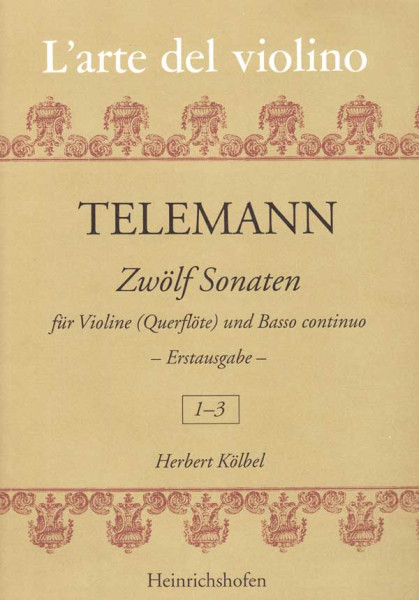
Georg Philipp Telemann
Twelve sonatas | sonatas 1 - 3 | volume 1 Violin ( flute) and basso continuo
First edition This edition is based on a manuscript from the Staatsbibliothek Berlin, Preußischer Kulturbesitz, Musikabteilung. It comes from the estate of Telemann, who gave it to his grandson Georg Michael Telemann (1748-1831). G. Poelchau acquired the manuscript in 1834 with a pack of music stored in a church tower in Riga. From Poelchau's estate († 1836) the sonata work came to the Royal Library in Berlin. The sonatas are dedicated to the brothers Rudolf, Hieronymus and Johannes Wilhelm Burmester of a Hamburg patrician family dated 1 March 1734, with the note that they follow the ‘12 methodical sonatas’, which were also dedicated to the first two brothers. The close connection between the two large sonata works can be found in their valuable musical content, in the sequence of movements (slow, fast, slow, fast), and in the succession of keys (C-a-D-h-E-F-d-G-e-A-f sharp-g). The bass lines are often involved in the theme. Occasionally we are reminded of J.S. Bach's inventions. In the title, the violin is named as the solo instrument before the flute, as several sonatas are unmistakably written “violinistically” without this hindering their playability for flute. The present edition adheres strictly to the manuscript. Suggestions for dynamics are indicated as such by brackets, as are those for articulation (by dotted lines), which may differ for violinists from those intended for flute. Experienced players should use the original figured bass for their own interpretation. The 12 sonatas made available to the public here for the first time are among the best compositions of this kind by Telemann, who dedicated them to 'connoisseurs and lovers' with the wish '...faire une bonne partie de Vos amusements'. The sonatas will fulfill this purpose today just as they did at that time.
Mehr €27.50 *
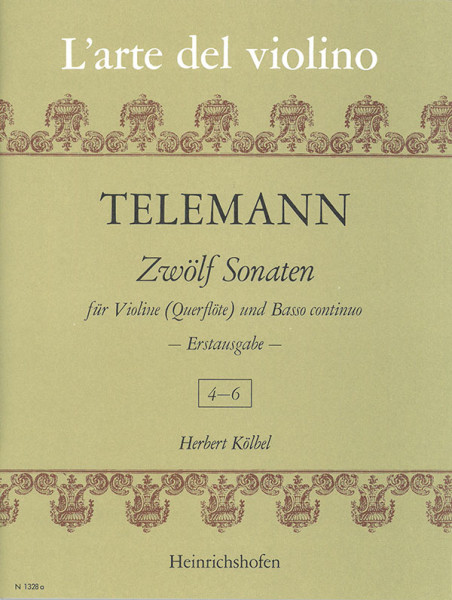
Georg Philipp Telemann
Twelve sonatas | sonatas 4 - 6 | volume 2 Violin (flute) and basso continuo
First edition This edition is based on a manuscript from the Staatsbibliothek Berlin, Preußischer Kulturbesitz, Musikabteilung. It comes from the estate of Telemann, who gave it to his grandson Georg Michael Telemann (1748-1831). G. Poelchau acquired the manuscript in 1834 with a pack of music stored in a church tower in Riga. From Poelchau's estate († 1836) the sonata work came to the Royal Library in Berlin. The sonatas are dedicated to the brothers of a Hamburg patrician family (Rudolf, Hieronymus and Johannes Wilhelm Burmester) dated 1 March 1734, with the note that they follow the ‘12 methodical sonatas’, which were also dedicated to the first two brothers. The close connection between the two large sonata works can be found in their valuable musical content, in the sequence of movements (slow, fast, slow, fast), and in the succession of keys (C-a-D-h-E-F-d-G-e-A-f sharp-g). The bass lines are often involved in the theme. Occasionally we are reminded of J.S. Bach's inventions. In the title, the violin is named as the solo instrument before the flute, as several sonatas are unmistakably written “violinistically” without this hindering their playability for flute. The present edition adheres strictly to the manuscript. Suggestions for dynamics are indicated as such by brackets, as are those for articulation (by dotted lines), which may differ for violinists from those intended for flute. Experienced players should use the original figured bass for their own interpretation. The 12 sonatas made available to the public here for the first time are among the best compositions of this kind by Telemann, who dedicated them to ' connoisseurs and lovers' with the wish '. ..faire une bonne partie de Vos amusements' . The sonatas will fulfill this purpose today just as they did at that time. Content: IV. Largo Allegro Andante Vivace V. Largo Allegro Grave Vivace VI. Andante Presto Cantabile Vivace
Mehr €27.50 *
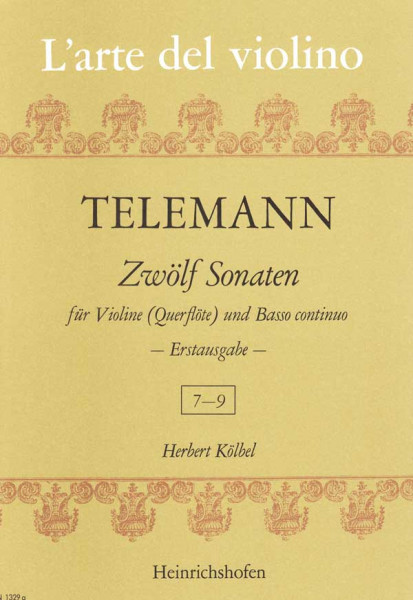
Georg Philipp Telemann
Twelve sonatas | sonatas 7 - 9 | volume 3 Violin (flute) and Basso continuo
First edition This edition is based on a manuscript from the Staatsbibliothek Berlin, Preußischer Kulturbesitz, Musikabteilung. It comes from the estate of Telemann, who gave it to his grandson Georg Michael Telemann (1748-1831). G. Poelchau acquired the manuscript in 1834 with a pack of music stored in a church tower in Riga. From Poelchau's estate († 1836) the sonata work came to the Royal Library in Berlin. The sonatas are dedicated to the brothers Rudolf, Hieronymus and Johannes Wilhelm Burmester of a Hamburg patrician family dated 1 March 1734, with the note that they follow the ‘12 methodical sonatas’, which were also dedicated to the first two brothers. The close connection between the two large sonata works can be found in their valuable musical content, in the sequence of movements (slow, fast, slow, fast), and in the succession of keys (C-a-D-h-E-F-d-G-e-A-f sharp-g). The bass lines are often involved in the theme. Occasionally we are reminded of J.S. Bach's inventions. In the title, the violin is named as the solo instrument before the flute, as several sonatas are unmistakably written “violinistically” without this hindering their playability for flute. The present edition adheres strictly to the manuscript. Suggestions for dynamics are indicated as such by brackets, as are those for articulation (by dotted lines), which may differ for violinists from those intended for flute. Experienced players should use the original figured bass for their own interpretation. The 12 sonatas made available to the public here for the first time are among the best compositions of this kind by Telemann, who dedicated them to 'connoisseurs and lovers' with the wish '...faire une bonne partie de Vos amusements'. The sonatas will fulfill this purpose today just as they did at that time.
Mehr €27.50 *
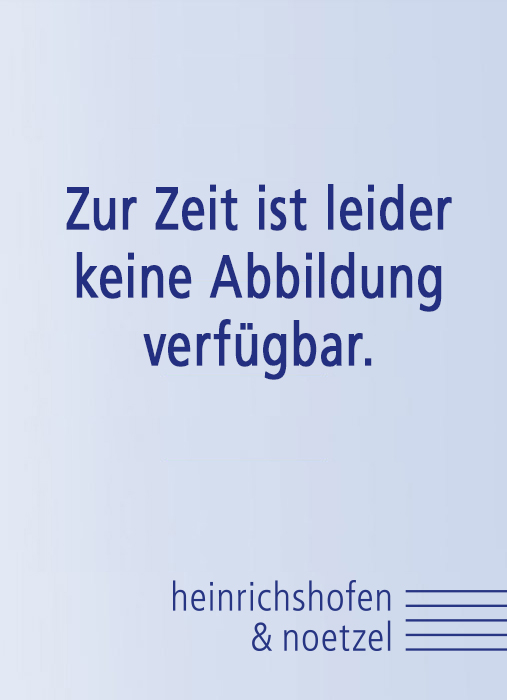
Wilhelm Brade
New außerlesene Paduanen, Galliarden / Cantzonen, Allmand... Partitur: N 1239-P Stimmen komplett: N 1239-SS
Mehr €4.00 *

Wilhelm Brade
Newe außerlesene Paduanen, Galliarden / Cantzonen,... Partitur: N 1239-P Stimmen komplett: N 1249-SS
Mehr €4.00 *
Viewed
